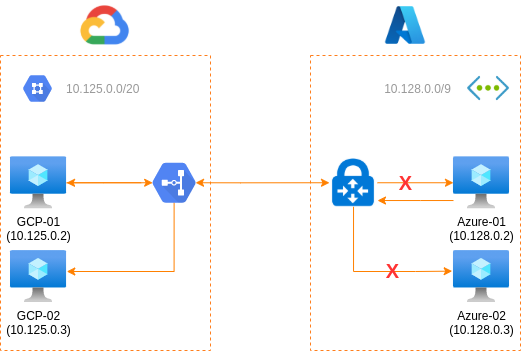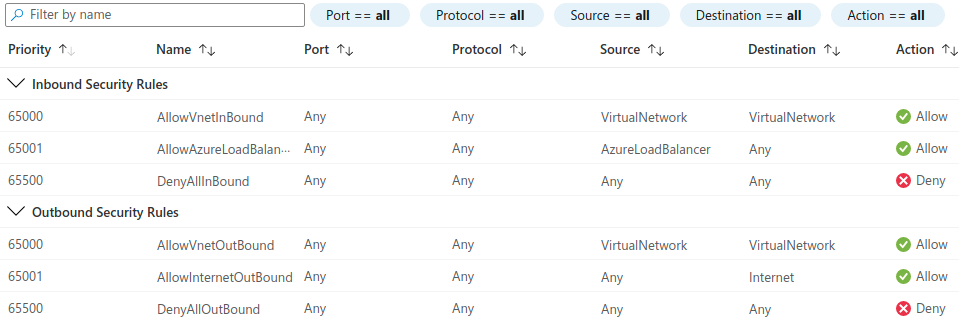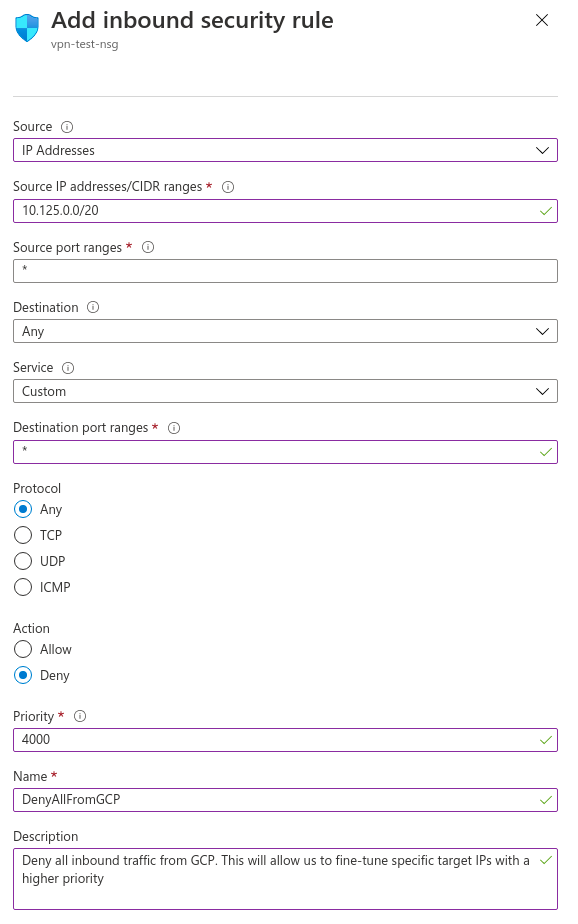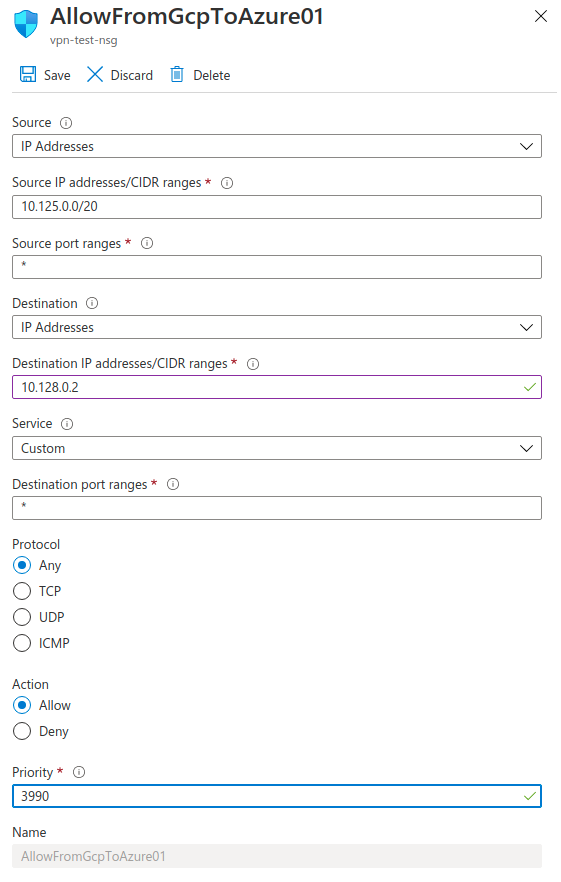VPN Site-to-Site between Azure and Google Cloud Platform. Part 3

If you had been following along, in the first part, we create a Site-to-Site VPN between Azure and GCP. In the second part we tested that connection successfully. Now it’s time to secure it
Current scenario
At this point, we added 2 more VMs. Now we have 2 VMs on Azure and 2 VMs on GCP:
| VM | Cloud Provider | Private IP |
|---|---|---|
| GCP-01 | Google Cloud | 10.125.0.2 |
| GCP-02 | Google Cloud | 10.125.0.3 |
| Azure-01 | Azure | 10.128.0.2 |
| Azure-02 | Azure | 10.128.0.3 |
The goal
Protect the network on Azure, allowing only specific IPs to be reached, in a maintainable way. This means that later on, we can change which IPs are whitelisted without the need to re-deploy a new VPN.
On the first test we will prevent any incoming traffic to the Azure VNet keeping the outgoing traffic to the GCP network:
| From | To | Can connect? |
|---|---|---|
GCP-01 |
Azure-01 |
No |
GCP-01 |
Azure-02 |
No |
GCP-02 |
Azure-01 |
No |
GCP-02 |
Azure-02 |
No |
Azure-01 |
GCP-01 |
Yes |
Azure-01 |
GCP-02 |
Yes |
Azure-02 |
GCP-01 |
Yes |
Azure-02 |
GCP-02 |
Yes |

And, in the second test we will allow incoming traffic to only the Azure-01 VM:
| From | To | Can connect? |
|---|---|---|
GCP-01 |
Azure-01 |
Yes |
GCP-01 |
Azure-02 |
No |
GCP-02 |
Azure-01 |
Yes |
GCP-02 |
Azure-02 |
No |
Azure-01 |
GCP-01 |
Yes |
Azure-01 |
GCP-02 |
Yes |
Azure-02 |
GCP-01 |
Yes |
Azure-02 |
GCP-02 |
Yes |

How can we secure our Azure VPN?
Our Virtual Network Gateway was associated with a VNet (default-vnet with one subnet), and there is where we can protect our resources. We will use the Network Security Group (NSG) with some custom rules. But first, let’s create the NSG


If we go to the resource overview page we can take a look into the inbound and outbound security rules

Now, we go to the VNet we want to secure and in the subnet, we apply the vpn-test-ng Network Security Group

We are now ready to start to implement our rules!
First test
In the Network Security Group, we go to the Inbound security rules on the sidebar and click on the Add button. Let’s see what we need:
| Field | Description | Value |
|---|---|---|
| Source | Specify the incoming traffic from a specific type of source | IP Addresses |
| Source IP addresses / CIDR ranges | CIDR of the source network | 10.125.0.0/20 |
| Source port ranges | From which ports this rule will take effect | * |
| Destination | Specify the outgoing traffic of this rule | Any |
| Service | Specify the destination protocol and port range for this rule | Custom |
| Destination port ranges | Ports of the destination targets | * |
| Protocol | To which protocol this rule will take effect | Any |
| Action | Define if this rule will allow or deny the traffic if the conditions are met | Deny |
| Priority | Sets the priority of this rule. Azure will evaluate from the lowest highest priority until it found a match rule | 4000 |
We will use a high priority value because this is our fallback rule, denying everything. Later on, we can add specific rules to allow more narrowed traffic.

Our network should be secure from incoming traffic through the VPN. Let’s check if we still have access to the GCP network:
1
2
3
4
5
6
7
8
9
10
azureuser@Azure-01$ ping 10.125.0.2 -c 4
PING 10.125.0.2 (10.125.0.2) 56(84) bytes of data.
64 bytes from 10.125.0.2: icmp_seq=1 ttl=64 time=50.644 ms
64 bytes from 10.125.0.2: icmp_seq=2 ttl=64 time=48.559 ms
64 bytes from 10.125.0.2: icmp_seq=3 ttl=64 time=53.577 ms
64 bytes from 10.125.0.2: icmp_seq=4 ttl=64 time=49.720 ms
--- 10.125.0.2 ping statistics ---
4 packets transmitted, 4 received, 0% packet loss, time 3076ms
rtt min/avg/max/mdev = 48.559/50.625/53.577/2.063 ms
Awesome, everything keeps working! Let’s try from GCP now:
1
2
3
4
5
6
7
8
9
10
ubuntu@GCP-01$ ping 10.128.0.2 -c 4
PING 10.128.0.2 (10.128.0.2) 56(84) bytes of data.
^C
--- 10.128.0.2 ping statistics ---
4 packets transmitted, 0 received, 100% packet loss, time 3057ms
ubuntu@GCP-01$ ping 10.128.0.3 -c 4
PING 10.128.0.3 (10.128.0.3) 56(84) bytes of data.
^C
--- 10.128.0.3 ping statistics ---
4 packets transmitted, 0 received, 100% packet loss, time 3053ms
1
2
3
4
5
6
7
8
9
10
ubuntu@GCP-02$ ping 10.128.0.2 -c 4
PING 10.128.0.2 (10.128.0.2) 56(84) bytes of data.
^C
--- 10.128.0.2 ping statistics ---
4 packets transmitted, 0 received, 100% packet loss, time 3053ms
ubuntu@GCP-02$ ping 10.128.0.3 -c 4
PING 10.128.0.3 (10.128.0.3) 56(84) bytes of data.
^C
--- 10.128.0.3 ping statistics ---
4 packets transmitted, 0 received, 100% packet loss, time 3057ms
Excellent, our network is secure from any connection from the GCP network.
Second test
It’s time to open only the Azure-01 VM to the GCP network. This can be done by creating a new Incoming security rule:

In this rule, we will use the IP Adresses destination with Azure-01 VM as the destination IP Address and the Allow action. Let’s apply and try it out!
1
2
3
4
5
6
7
8
9
10
11
12
13
14
15
ubuntu@GCP-01$ ping 10.128.0.2 -c 4
PING 10.125.0.2 (10.125.0.2) 56(84) bytes of data.
64 bytes from 10.125.0.2: icmp_seq=1 ttl=64 time=50.644 ms
64 bytes from 10.125.0.2: icmp_seq=2 ttl=64 time=48.559 ms
64 bytes from 10.125.0.2: icmp_seq=3 ttl=64 time=53.577 ms
64 bytes from 10.125.0.2: icmp_seq=4 ttl=64 time=49.720 ms
--- 10.125.0.2 ping statistics ---
4 packets transmitted, 4 received, 0% packet loss, time 3076ms
rtt min/avg/max/mdev = 48.559/50.625/53.577/2.063 ms
ubuntu@GCP-01$ ping 10.128.0.3 -c 4
PING 10.128.0.3 (10.128.0.3) 56(84) bytes of data.
^C
--- 10.128.0.3 ping statistics ---
4 packets transmitted, 0 received, 100% packet loss, time 3053ms
1
2
3
4
5
6
7
8
9
10
11
12
13
14
15
ubuntu@GCP-02$ ping 10.128.0.2 -c 4-
PING 10.125.0.2 (10.125.0.2) 56(84) bytes of data.
64 bytes from 10.125.0.2: icmp_seq=1 ttl=64 time=50.644 ms
64 bytes from 10.125.0.2: icmp_seq=2 ttl=64 time=48.559 ms
64 bytes from 10.125.0.2: icmp_seq=3 ttl=64 time=53.577 ms
64 bytes from 10.125.0.2: icmp_seq=4 ttl=64 time=49.720 ms
--- 10.125.0.2 ping statistics ---
4 packets transmitted, 4 received, 0% packet loss, time 3076ms
rtt min/avg/max/mdev = 48.559/50.625/53.577/2.063 ms
ubuntu@GCP-02$ ping 10.128.0.3 -c 4
PING 10.128.0.3 (10.128.0.3) 56(84) bytes of data.
^C
--- 10.128.0.3 ping statistics ---
4 packets transmitted, 0 received, 100% packet loss, time 3057ms
Awesome! We can now limit which IP addresses can be reached from the other side of the VPN, thus securing our network.
If you have a VPN device and wish to connect to the Azure VPN, you can refer to the official documentation and check the default values used in this VPN implementation.
Hope you found this series useful.